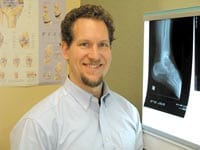Pain Relief or Placebo? – Studies Cast Doubt on the Use of Glucosamine for Osteoarthritis
When faced with chronic pain, it’s natural to wish for a cure-all pill, one that will take away the discomfort with minimal side effects.
“We often want to have a magic medicine to get us all better,” said Dr. Darius Greenbacher. “But everyone knows, deep down, that there isn’t one.”
That fact hasn’t slowed the popularity of glucosamine in the treatment of osteoarthritis, especially in the knee — even though research has been piling up suggesting it really doesn’t have much of an effect.
“If you’re a dog, it works well. There’s some pretty good, proven evidence of that,” said Greenbacher, medical director of Baystate Medical Practices — Sports and Exercise Medicine. “But in human studies — and there have been several big studies — they’ve shown it’s no better than a placebo.”
Glucosamine is a compound naturally produced in the human body, and is involved in the creation of molecules that form cartilage. Glucosamine sulfate supplements are popular based on the idea that they may help strengthen cartilage, thereby reducing arthritic joint pain. They are often taken together with chondroitin, a complex carbohydrate that helps cartilage retain water.
However, studies have repeatedly suggested that any benefit is largely a placebo effect. The often-cited Glucosamine/Chondroitin Arthritis Intervention Trial, or GAIT, the results of which were released in 2010, was the first large-scale, multi-center clinical trial in the U.S. to test glucosamine and chondroitin, alongside a common pain-relieving drug, for treatment of knee osteoarthritis.
The double-blind study revealed no significant benefit from glucosamine — a result that has been repeated in other trials. Still, because the supplement is relatively inexpensive and not associated with the side effects of some pain medications, doctors often don’t stand in the way of patients taking it.
“Often, I get asked by patients what I think about this,” Greenbacher said. “There are few downsides, other than the cost, which is not outrageous. There could be some stomach upset or constipation in large doses, but, really, there’s no significant downside. So my recommendation, if they’re interested, is to take it for a short time and see if there’s any improvement in the joint pain. If there is, continue to take it. If there’s no improvement, don’t continue to take it; put that money elsewhere.”
GAIT Crashers
Osteoarthritis is the most common form of arthritis, affecting an estimated 27 million adults in the U.S. Also known as degenerative joint disease, it’s caused by the breakdown of cartilage, the connective tissue that cushions the bones within a joint.
Characterized by pain, joint damage, and limited motion, the condition usually occurs late in life. Females are more commonly affected than men, and obesity is a significant risk factor.
The GAIT study was an eye-opener in the arthritis-treatment world. The University of Utah School of Medicine coordinated the effort at 16 rheumatology research centers across the U.S. Participants were randomly assigned to one of five treatment groups: glucosamine alone, chondroitin alone, glucosamine and chondroitin in combination, celecoxib (a prescription drug effective at managing osteoarthritis pain), or a placebo.
Participants — 1,229 with mild pain and 354 with moderate to severe pain — received treatment for 24 weeks, and neither they nor the researchers knew who was in which treatment group.
Participants taking celecoxib experienced significant pain relief versus those taking the placebo, with about 70{06cf2b9696b159f874511d23dbc893eb1ac83014175ed30550cfff22781411e5} reporting a 20{06cf2b9696b159f874511d23dbc893eb1ac83014175ed30550cfff22781411e5} or greater reduction in pain versus about 60{06cf2b9696b159f874511d23dbc893eb1ac83014175ed30550cfff22781411e5} for placebo. Those taking glucosamine, chondroitin, or a combination reported pain-relief results at a rate just a few points higher than the placebo group — a disappointing result for those hoping to see proven benefits from the supplements.
Other studies have fallen in line with these results, including a recent double-blind trial of 200 patients conducted by the University of Arizona and published last month in Arthritis & Rheumatology.
Participants, whose knee pain ranged from mild to moderate, were randomly assigned to drink either a glass of lemonade containing glucosamine, or plain lemonade (a placebo), every day for six months. Neither the participants nor the researchers knew which treatment each received.
At the end of the study, participants who took glucosamine were just as likely as those who took the placebo to experience loss of knee cartilage, and there was no difference in the amount of pain reported by patients in each group.
“The jury is in, and we have given these supplements a fair try,” Dr. David Pisetsky, chief of Rheumatology at Duke University Medical Center, told WebMD last month. “I don’t think there is a strong impetus for more study.”
Meanwhile, a recent analysis of 10 different studies reinforce the growing thought that glucosamine isn’t an effective remedy for osteoarthritic pain — but that doesn’t necessarily mean no one should take them. The striking pain-relief results from the placebo group in the GAIT study suggest patients, at the very least, aren’t harming themselves by taking the pills.
“We see no harm in having patients continue these preparations as long as they perceive a benefit and cover the cost of treatment themselves,” write the researchers, who were led by Peter Jüni of the University of Bern in Switzerland.
Not the Only Answer
Greenbacher agrees, but adds that he worries about patients relying only on glucosamine while neglecting other joint-pain treatments that have actually been proven to work.
“These are interventions that are going to have a better effect on a person’s quality of life,” he said. “I want to make sure they’re staying active, make sure they’re staying strong and as flexible as possible, working on a balance of those things. Those things really improve the arthritis, and help keep you as active and healthy as possible.”
Because of the low cost and almost non-existent side effects, Greenbacher doesn’t mind people trying glucosamine, but says it’s much more important that they talk to a physical therapist and develop an exercise program that involves both cardiovascular and weight-training work and focuses on posture and position.
He noted, however, that concerns have been raised about other ingredients in supplements, such as high levels of antioxidants like vitamin E, and the fact that the U.S. Food and Drug Administration provides little oversight of those components, since the pills are classified as a food. “It’s the idea that, if a little is good for you, a lot is better, and it’s not true,” he said. “I believe in moderation in all things, as the saying goes.”
People with chronic knee pain, however, aren’t thinking about moderation; they’re just hoping for relief. When it comes to glucosamine, believing they’ve found that relief may be half the battle. v




Comments are closed.